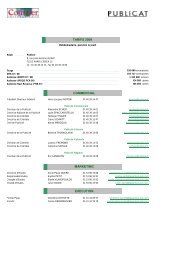2 ОРГАНИЗАЦИЯ И МЕТОДИКА РАБОТ - Courrier international
2 ОРГАНИЗАЦИЯ И МЕТОДИКА РАБОТ - Courrier international
2 ОРГАНИЗАЦИЯ И МЕТОДИКА РАБОТ - Courrier international
Create successful ePaper yourself
Turn your PDF publications into a flip-book with our unique Google optimized e-Paper software.
personnel with the simultaneous decrease of one-time concentrations in atmospheric air and leading<br />
to the chronic nature of soil (ground) water contamination with this group of pollutants.<br />
Polycyclic aromatic hydrocarbons (PAH)<br />
The sources of PAH intake into the environment can be divided into anthropogenic and natural<br />
ones. The natural sources are volcanic outbursts, hydrocarbon anomalies in tectonically active<br />
zones, endogenous geological processes, hydrothermal sources, hydrocarbon fluxes from gas and<br />
oil, coal and shale fields, synthesis of PAH in old and modern sedimentary rocks and forest fires.<br />
The natural processes leading to the formation of PAH in such a way can be related to the synthesis<br />
without the participation of biomass at high (1000 °C and higher), medium (400-500 °C) and low<br />
(100-150 °C) temperatures and with the conversion of the components of buried biomass in<br />
sedimentary rocks in thermal catalytic reactions at temperatures from 80 to 200 °C.<br />
The main anthropogenic sources of PAH are related to various production processes, among which<br />
more than half of emissions come from power generation (due to incomplete combustion of organic<br />
fuels such as coal, oil products and woods. Also coke-chemical and oil processing plants and<br />
exhaust gases from vehicles make a significant contribution to the total PAH content.<br />
It should be noted that the qualitative composition and structure of PAH from natural abiogenic<br />
sources do not differ from those of anthropogenic origin if they are formed as a result of the high<br />
and medium temperature processes while the low temperature conversion of organic matter leads to<br />
the formation of aryl and alkyl substituted hydrocarbons with a large number of substituents in the<br />
aromatic ring and with long-chain branchings.<br />
Among PAH formed during combustion process, the compounds without substituents in the<br />
aromatic ring such as phenanthrene, fluoranthene, pyrene, chrysene, benzpyrenes and<br />
dibenzpyrenes are dominant, while the content of monomethyl substituted homologs is 3-10 times<br />
lower. The ratio of specific PAHs in combustion products does not vary significantly during the<br />
transition from one source to the other, at the same time, the prevalence of specific compounds can<br />
be explained by their higher thermodynamic stability.<br />
The composition of polycyclic aromatic hydrocarbons of coal and oil origin differs from that of<br />
pyrolytic PAHs. In PAHs from coal fields and crude unfractionated oil, methyl derivatives of<br />
naphthalene, phenanthrene and chrysene prevail, while in unsubstituted PAHs phenanthrene and<br />
perylene. When hydrocarbons of natural origin are dispersed, PAHs can be directly discharged into<br />
ecosystems by means of both their migration and migration of more light hydrocarbons with their<br />
further transformation to PAHs in the presence of natural catalysts<br />
The study of trace amounts of PAHs in environmental objects is of great significance due to their<br />
relatively high chemical stability and high toxicity manifesting in their oncogenic, mutagenic and<br />
teratogenic effects and a capability to cause poisoning and disorder of the immune system when<br />
accumulating in organisms. Complex toxic effect on the organism allows to consider PAH to be the<br />
agents that transform biosphere, at the same time their effects are reflected both in current and<br />
future generations<br />
Among detectable PAHs, benz(a)pyrene and dibenz(a,h)anthracene have the strongest oncogenic<br />
properties; during laboratory experiments, tumors appeared even in breed from infected species.<br />
The presence of alkyl substituents in the aromatic ring can both increase and decrease oncogenic<br />
activity of PAHs. For example, 3.4-8.9- and 3.4-9.10 dibenzpyrene activity decreases after the<br />
FINAL REPORT for Contract No. CS-NPA-Arctic-13/2009 of December 01, 2009 within the framework of pilot project Development of<br />
Technology of clean up of the area of Decommissioned Sites of The Russian Federation Ministry of Defense in the Arctic by the<br />
Example of Alexanra Island of Franz Josef Land Archipelago from Hazardous Waste<br />
72








